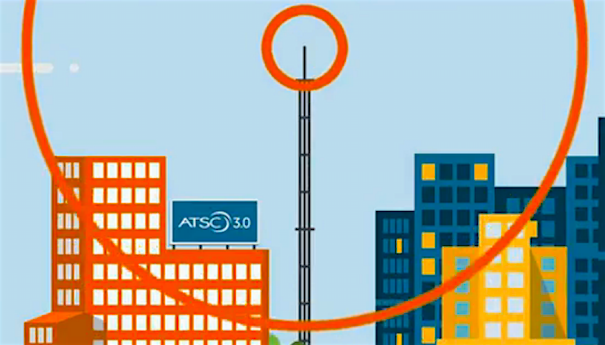ATSC 3.0: A Revolution for U.S. Broadcasters
The ATSC 3.0 standard brings an exciting time for U.S. broadcasters as a flood of new tools hits the market equipping traditional broadcasters to explore what Hybrid TV has to offer. By drawing on Europe as an example, U.S. broadcasters have access to a series of real-life examples of the ways traditional broadcasters have expanded their reach into digital through Hybrid TV. Europe has in fact been a Hybrid TV pioneer and has witnessed the debunking of traditional “TV watching.”

With consumers spending on average four hours a day watching video content, it is clear that broadcasters still retain a lot of leverage. Even though competition is increasing between different platforms for digital content (social media, TV streaming, game consoles, etc.) it is safe to say that traditional TV is a reliable output for advertising as 10% of the U.S. population flick through varying channels when watching TV. Not to mention, older generations who are more likely to flick through channel to channel are more often than not going to be financially better placed to spend more, making it clear to broadcasters that in order to meet existing viewer demand choosing either OTT or traditional TV is futile.
In order to remain profitable (through a greater share of ad spending) and to ensure interest from consumers is kept at an all-time high, U.S. broadcasters need to make the most of what ATSC 3.0 has to offer. In this article, we look at the top trends for U.S. TV content delivery and their potential to drive advertising and viewer stickiness.
MAKE IT PERSONAL
In order to improve channel stickiness, knowing and understanding your consumer in order to provide targeted content will be key. Many OTT providers offer short snippets of content specifically tailored to individual consumers—for example a preview window showing the next episode of a TV series. These “snipes,” which can be programmed to appear at the bottom of the screen during a program, can now be altered to be far more powerful: with ATSC 3.0, broadcasters can insert pop out adverts that appear when a program has finished airing based on the viewer’s specific content preferences.
ADVERTISING’s NEXT FRONTIER
ATSC 3.0 paves the way for an exciting new development in advertising: addressable advertising. Businesses will be able to target content specifically to households and even individuals within a household, thus limiting wasted efforts on untargeted ads. Of the 120 million TV homes in the U.S., more than 65 million have the technology to receive these targeted ads, however this type of advertising is clearly very under-used. Looking at the U.K. as an example, Sky credited a 29% year-on-year rise in revenues for its targeted advertising platform AdSmart for driving overall U.K. and Ireland ad revenue growth of 6%.
The professional video industry's #1 source for news, trends and product and tech information. Sign up below.
LOCATION, LOCATION, LOCATION
Targeted location selection can improve effectiveness and ultimately reduce brands’ ad spending. A great example of a brand rolling this out is from car brand Suzuki, which implemented an addressable advert to raise awareness to viewers about nearby dealerships. Toyota has taken this a step further, where they ran an addressable TV ad campaign that connected TV ads to dealership visits, where they were able to assess whether the TV ads led to an increase in foot traffic into the dealerships.
Location data can also help discourage channel switching, which will assist in increasing your share of advertisers’ budget as well as increasing their loyalty to you. An example of this is providing real time regional news pop-ups between shows—delivering pertinent information to TV viewers.
INCENTIVES
Another way to increase interactions with viewers is to offer incentives or rewards. For example, a brand could offer viewers a voucher code that can be redeemed on their tablet or smartphone. Given that 95% of consumers watch TV with a mobile device in hand, interacting with adverts to redeem offers will not be a difficult task.
INTERACTIVE ADVERTISING
The concept of traditional advertising rests on the premise that the ad needs to stay in viewers’ minds as opposed to initiating immediate action. Hybrid TV allows additional content to be added to an advert, giving consumers access to the key information in real-time and increasing the likelihood of inspiring immediate action. If a car manufacturer is advertising its latest model with this wave of advertising, they would have the functionality to offer viewers the option of a test drive all through the click of a button on their TV.
Hybrid TV is altering the media landscape for broadcasters by increasing competition and changing the way viewers consume content. However, there is a wealth of opportunity for broadcasters adopting Next Gen TV as they are ideally placed to beat the competition from sole OTT players in the market. Not only will broadcasters be able to individually target their viewers to increase stickiness, but they will provide suitable platforms for advertisers to custom their ads to individuals increasing overall quantity of interactions. It is time that broadcasters in the U.S. look to Europe and plan a roadmap for ATSC 3.0 adoption to target consumers in an increasingly more personalized manner, all while guaranteeing steady revenues from advertisers and seeing off competitors to mark their place firmly in the market.
Jarvis leads international IT services firm Fincons’ U.S. business. Over the past 18 years he has launched multiple OTT and TV delivery products and services. He currently leads the efforts to design and deploy Next Gen User Experiences and recently released the TV interface best practices design and accompanying book.
For a comprehensive source of TV Technology’s ATSC 3.0 coverage, see ourATSC3 silo.
